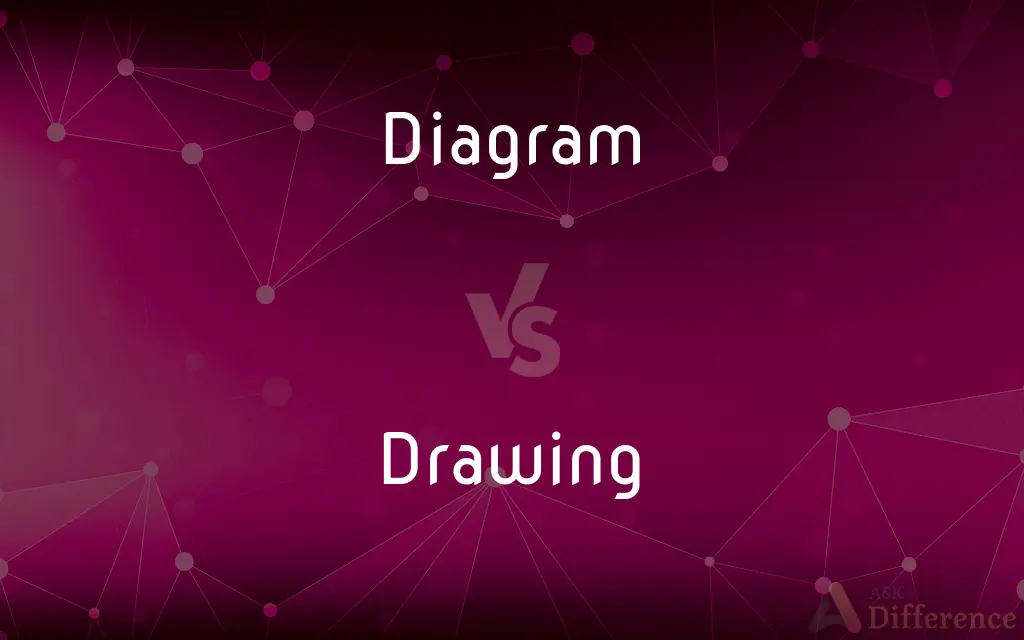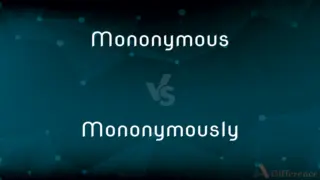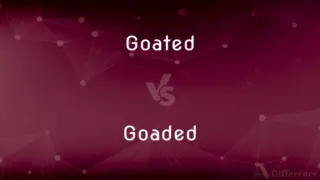Diagram vs. Drawing — What's the Difference?
By Tayyaba Rehman — Updated on October 31, 2023
A diagram is a simplified drawing representing data or a system with symbols, lines, and shapes, whereas a drawing is a picture created with lines, shading, and artistic techniques.

Difference Between Diagram and Drawing
Table of Contents
ADVERTISEMENT
Key Differences
A diagram is a visual representation that typically conveys technical or complex information through abstract, simplified forms such as lines, symbols, and shapes. Diagrams are used to illustrate relationships and processes systematically. In contrast, a drawing is an artwork or representation created with lines on a surface, showing the appearance, structure, or workings of something.
Diagrams are often used in educational and professional fields to distill and communicate complex information in a digestible format. They serve specific purposes in science, engineering, and mathematics. On the other hand, drawings are more associated with the expression of creative ideas, and they may depict anything from realistic portraits to abstract compositions.
The key distinction between a diagram and a drawing lies in their intent. A diagram is generally intended to be an informative tool that explains and simplifies, often created with the intention of clarity and universality. Drawings, however, are as varied as the artists who create them, often valued for their aesthetic qualities and the skill evident in their creation.
In creating diagrams, the focus is on accuracy and the efficient communication of information, often following certain standards or conventions. Drawings, though they can be precise, are more about individual expression and are as unique as their creators, sometimes conveying emotions, moods, or personal styles.
Diagrams are characteristically found in textbooks, instruction manuals, and scientific papers, often labeled and designed to be referred to for specific information. In contrast, drawings may be found in galleries, homes, or as part of design processes, admired for their beauty or used to conceptualize ideas.
ADVERTISEMENT
Comparison Chart
Purpose
To represent data or systems.
To create a picture or artwork.
Features
Simplified, uses symbols.
Detailed, uses artistic techniques.
Usage
In educational, technical fields.
In art, design, personal expression.
Representation
Abstract, structured.
Realistic or abstract, free-form.
Intention
To inform and clarify.
To express or depict artistically.
Compare with Definitions
Diagram
Informational Tool
We used a Venn diagram to compare the two topics.
Drawing
Pencil Artwork
He gifted me a drawing of my favorite pet.
Diagram
Technical Illustration
The architect's diagram showed the building's design.
Drawing
Sketch
The designer created a drawing for the new dress.
Diagram
Schematic Representation
The electrical circuit was explained using a clear diagram.
Drawing
Concept Visualization
Her drawing brought the idea to life.
Diagram
Visual Guide
Follow the diagram to assemble the furniture.
Drawing
Creative Expression
Children often express their emotions through drawing.
Diagram
A diagram is a symbolic representation of information using visualization techniques. Diagrams have been used since ancient times on walls of caves, but became more prevalent during the Enlightenment.
Drawing
Drawing is a form of visual art in which an artist uses instruments to mark paper or other two-dimensional surface. Drawing instruments include graphite pencils, pen and ink, various kinds of paints, inked brushes, colored pencils, crayons, charcoal, chalk, pastels, erasers, markers, styluses, and metals (such as silverpoint).
Diagram
A simplified drawing showing the appearance, structure, or workings of something; a schematic representation
A diagram of the living room
Drawing
The act or an instance of drawing.
Diagram
Represent (something) in graphic form
The experiment is diagrammed on page fourteen
Drawing
The art of representing objects or forms on a surface chiefly by means of lines.
Diagram
A plan, sketch, drawing, or outline designed to demonstrate or explain how something works or to clarify the relationship between the parts of a whole.
Drawing
A work produced by this art.
Diagram
(Mathematics) A graphic representation of an algebraic or geometric relationship.
Drawing
Present participle of draw
Diagram
A chart or graph.
Drawing
A picture, likeness, diagram or representation, usually drawn on paper.
Diagram
To indicate or represent by or as if by a diagram.
Drawing
The act of producing such a picture.
Diagram
A plan, drawing, sketch or outline to show how something works, or show the relationships between the parts of a whole.
Electrical diagrams show device interconnections.
Drawing
Such acts practiced as a graphic art form.
Diagram
A graph or chart.
Drawing
The process of drawing or pulling something.
Proverb: An official is great in his office as a well is rich in drawings of water.
Diagram
(category theory) A functor from an index category to another category. The objects and morphisms of the index category need not have any internal substance, but rather merely outline the connective structure of at least some part of the diagram's codomain. If the index category is J and the codomain is C, then the diagram is said to be "of type J in C".
Drawing
An act or event in which the outcome (e.g., designating a winner) is selected by chance in the form of a blind draw, notably of lots; especially such a contest in which a winning name or number is selected randomly by removing (or drawing) it from a container, popularly a hat.
Diagram
(transitive) To represent or indicate something using a diagram.
Drawing
A small portion of tea for steeping.
Diagram
(UK) To schedule the operations of a locomotive or train according to a diagram.
Drawing
The act of pulling, or attracting.
Diagram
A figure or drawing made to illustrate a statement, or facilitate a demonstration; a plan.
Drawing
The act or the art of representing any object by means of lines and shades; especially, such a representation when in one color, or in tints used not to represent the colors of natural objects, but for effect only, and produced with hard material such as pencil, chalk, etc.; delineation; also, the figure or representation drawn.
Diagram
Any simple drawing made for mathematical or scientific purposes, or to assist a verbal explanation which refers to it; a mechanical drawing, as distinguished from an artistical one.
Drawing
The process of stretching or spreading metals as by hammering, or, as in forming wire from rods or tubes and cups from sheet metal, by pulling them through dies.
Diagram
To put into the form of a diagram.
Drawing
The process of pulling out and elongating the sliver from the carding machine, by revolving rollers, to prepare it for spinning.
Diagram
A drawing intended to explain how something works; a drawing showing the relation between the parts
Drawing
The distribution of prizes and blanks in a lottery.
Diagram
Make a schematic or technical drawing of that shows how things work or how they are constructed
Drawing
An illustration that is drawn by hand and published in a book or magazine;
It is shown by the drawing in Fig. 7
Diagram
Educational Aid
The diagram in the book illustrated the human digestive system.
Drawing
A representation of forms or objects on a surface by means of lines;
Drawings of abstract forms
He did complicated pen-and-ink drawings like medieval miniatures
Drawing
The creation of artistic drawings;
He learned drawing from his father
Drawing
Players buy (or are given) chances and prizes are distributed according to the drawing of lots
Drawing
Act of getting or draining something such as electricity or a liquid from a source;
The drawing of water from the well
Drawing
The act of moving a load by drawing or pulling
Drawing
Artistic Creation
The artist's drawing captured the landscape beautifully.
Common Curiosities
What materials are used to create diagrams?
Diagrams can be made with pen, pencil, or digital tools, emphasizing clarity over artistic style.
Are all drawings considered diagrams?
No, not all drawings are diagrams; many are artistic and not meant for structured information.
What is a diagram?
A diagram is a structured visual representation used to communicate information clearly and efficiently.
Can diagrams be considered drawings?
Yes, diagrams are a type of drawing with a specific focus on information and structure.
What materials are used for drawings?
Drawings are created with a variety of tools including pencils, inks, charcoal, and digital pens.
What skills are required to create diagrams?
Skills in abstract thinking and clarity in representation are important for creating diagrams.
What skills are important for drawing?
Artistic skills, creativity, and a good understanding of form and shading are important for drawing.
Can drawings be abstract?
Yes, drawings can be highly abstract and open to interpretation.
Is color important in diagrams?
Color can be used in diagrams to clarify, but it's not always necessary.
What is a drawing?
A drawing is a representation created with lines and shading to depict subjects artistically.
Do diagrams have to be accurate?
Yes, diagrams aim for accuracy to effectively communicate specific information.
Where are drawings usually displayed?
Drawings may be displayed in galleries, used in design processes, or kept personal for enjoyment.
Are diagrams artistic?
While diagrams can have aesthetic qualities, their main purpose is to convey information, not artistry.
Do drawings always depict real objects?
No, drawings can depict real objects, abstract ideas, or be purely imaginative.
Where would you typically find diagrams?
Diagrams are commonly found in instructional materials, scientific literature, and technical documentation.
Share Your Discovery

Previous Comparison
Mononymous vs. Mononymously
Next Comparison
Goated vs. GoadedAuthor Spotlight
Written by
Tayyaba RehmanTayyaba Rehman is a distinguished writer, currently serving as a primary contributor to askdifference.com. As a researcher in semantics and etymology, Tayyaba's passion for the complexity of languages and their distinctions has found a perfect home on the platform. Tayyaba delves into the intricacies of language, distinguishing between commonly confused words and phrases, thereby providing clarity for readers worldwide.















































